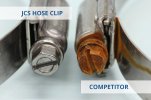Milehighguy303
Active Member
Background: flying along at 60 mph on my well maintained 2007 Seadoo GTI SE 155 with 250 hours, enjoying a new jet pump, my exhaust temp warning light came on and I shut the engine off. I sprung a leak in my exhaust cooling system, and my ski very slowly started to sink as I waited for a kind boater to come along and tow me. My Good Samaritan boater couldn’t get me all the way to the dock due to shallow water, and by the time I could get to the dock, my ski was nearly sunk. I had actually tried to idle in and hang on the side of the ski - didn’t work. Wanting to try idling again, the engine water locked while turning over to start, but not running. Got home, pulled plugs, pumped water out of the cylinders, and started the ski. Idled perfectly at the 1700 RPM for 3-4 seconds, then seemed to water lock and stopped running In an instant. I pumped more water out of the cylinders (but not as much as I had previously) and started again. It ran very rough, seemed like on 2 cylinders, but I was able to accelerate a little bit, rev the throttle slightly. I shut it off, disappointed that I had bent a piston connecting rod when I started it the first time and it water locked up at idle. So I thought....
Before I start shopping for a new Seadoo, I thought I would check compression, to confirm my suspected bent connecting rod theory. To my surprise, I have an even 120 psi in each cylinder. The likelihood of bending all 3 rods evenly is unlikely, and so I think my engine is actually ok. I still need to figure out where my exhaust cooling leak is at, why the ski stopped idling so abruptly, and why the ski is running so poorly now. But I have renewed confidence in the engine.
So the question is, what is good compression on a 155 engine? Is my renewed confidence that I don’t have Internal engine damage justified? I saw some post of 135 psi on a ski with 85 hours on it, another post of 185 psi (which sounds incorrect and impossible to me). Is my even 120 psi for all 3 cylinders reasonable? This was essentially a dry test too (for those wondering). Any opinions on my compression results? This ski always started easily and ran strong, until this recent ingestion event.
Hope to see you back on the water...
Before I start shopping for a new Seadoo, I thought I would check compression, to confirm my suspected bent connecting rod theory. To my surprise, I have an even 120 psi in each cylinder. The likelihood of bending all 3 rods evenly is unlikely, and so I think my engine is actually ok. I still need to figure out where my exhaust cooling leak is at, why the ski stopped idling so abruptly, and why the ski is running so poorly now. But I have renewed confidence in the engine.
So the question is, what is good compression on a 155 engine? Is my renewed confidence that I don’t have Internal engine damage justified? I saw some post of 135 psi on a ski with 85 hours on it, another post of 185 psi (which sounds incorrect and impossible to me). Is my even 120 psi for all 3 cylinders reasonable? This was essentially a dry test too (for those wondering). Any opinions on my compression results? This ski always started easily and ran strong, until this recent ingestion event.
Hope to see you back on the water...




